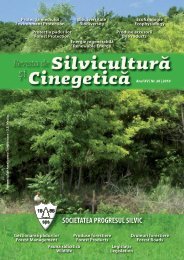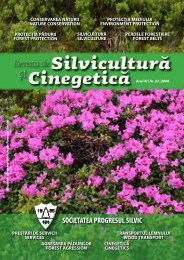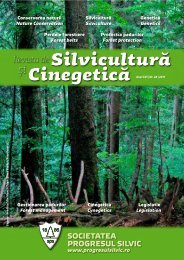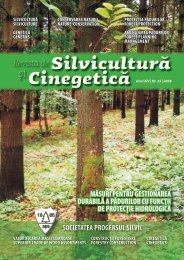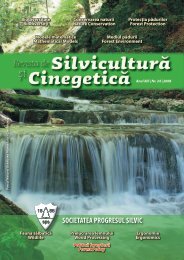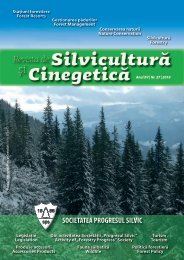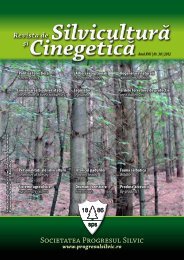Silviculture and Cinegetics Review - Societatea Progresul Silvic
Silviculture and Cinegetics Review - Societatea Progresul Silvic
Silviculture and Cinegetics Review - Societatea Progresul Silvic
Create successful ePaper yourself
Turn your PDF publications into a flip-book with our unique Google optimized e-Paper software.
FORESTRY BELTS SILVICULTURE AND CINEGETICS REVIEW XVII/30/2012<br />
- Mixture of black pine <strong>and</strong> more xerophytes species -<br />
flowering ash (ailanthus) <strong>and</strong> resistant trees - at the<br />
top of of the slope;<br />
- oleaster was placed in pure bunches on the ruptures<br />
<strong>and</strong> l<strong>and</strong>slides on the eastern slope respectively as<br />
column, the largest slope line for fixing against<br />
runoffs;<br />
- For the slope stability it was introduced a line of<br />
pure of oleaster (mid-of the slope);<br />
- At the edge, it was designed a hedge of blackthorn<br />
(thorn).<br />
Option 2, of backup (Table 4 b):<br />
- Black pine may not be replaced with any other main<br />
species of coniferous in Romania, which cannot<br />
withst<strong>and</strong> high pH <strong>and</strong> carbonate in the soil;<br />
- Mixed mesophilic species, common ash <strong>and</strong><br />
mountain maple are interchangeable;<br />
- help xerophytes species - flowering ash (Ailanthus),<br />
Turkestan elm, cherry-plum, <strong>and</strong> oleaster - can be<br />
interchangeable or substitute with Turkish cherry or<br />
mulberry (oleaster is not good to be replaced);<br />
- sea buckthorn <strong>and</strong> blackthorn, red dogwood, privet,<br />
Christ's thorn can replace each other, in extreme cases<br />
can be substituted by hawthorn, wild rose or vinegar<br />
tree, but resistance to specific site conditions <strong>and</strong> their<br />
protective role is weaker;<br />
- juniper not only supports dry <strong>and</strong> carbonate soils,<br />
fixing <strong>and</strong> protecting well the soils, but remains<br />
green, like black pine in the season of vegetation <strong>and</strong><br />
can not be replaced with any other species;<br />
- For hedges honey locust, blackthorn <strong>and</strong> sea<br />
buckthorn can replace each other, in extreme cases<br />
can be substituted by dog rose or hawthorn.<br />
The environmental protection forest belt, by its multifunctions,<br />
will have a complex structure, both<br />
vertically <strong>and</strong> horizontally. Thus, on the vertical will<br />
be ensured:<br />
- a main basic species: black pine, ensuring<br />
continuity of protection functions both in the growing<br />
season <strong>and</strong> during winter;<br />
- The main mixture species: common ash <strong>and</strong><br />
mountain maple (at the bottom <strong>and</strong> middle of the<br />
shaded slope) <strong>and</strong> ailanthus, cherry-plum <strong>and</strong> elm of<br />
Turkestan (on the sunny plateau <strong>and</strong> slope);<br />
- the help species: flowering ash (on the plateau,<br />
sunny slope <strong>and</strong> upper shaded slope) <strong>and</strong> oleaster<br />
(pure lines, at a relatively steady intervals, on the<br />
plateau <strong>and</strong> slopes);<br />
- species of shrubs: blackthorn, sea buckthorn<br />
(hedges <strong>and</strong> sunny areas), red dogwood, common<br />
privet, Christ's thorn (shaded areas) (backup options:<br />
vinegar tree, hawthorn, dog rose);<br />
- species for hedges: honey locust at the the basis of<br />
the sunny slopes, towards the enclosure, respectively<br />
shrubs at the basis of shadowed slopes, towards the<br />
surrounding agricultural l<strong>and</strong>.<br />
Horizontally the distribution of the 10 species was<br />
made as follows:<br />
- 1 row of intimate mixture of black pine, shrubs <strong>and</strong><br />
the help species<br />
- 1 row of intimate mixture of black pine <strong>and</strong> shrubs<br />
followed by mixing main species with shrubs;<br />
- from place to place was interposed a row of pure<br />
oleaster for fixing of the slope;<br />
- at the edges of the slope was planted a row of<br />
pure honey locust, for hedges (20,000 seedlings /<br />
ha).<br />
Table 4a. Kronospan protection forest belt – main afforestation scheme<br />
Shadowed slopes (N,E) Plateau Sunny slope (S,V)<br />
G<br />
v1<br />
2 3 4 5 6 7 8 9 10 11 12 13 14 15 16 17 18 19 20 21 22 23 24 25<br />
1 Gl Ct Fr Ip Sâ Pin Ct Sl Por Pin Sl Pin Por Mj Sl Ct Mj Ip Ct Pin Por Sl Por Ip Ct Gl<br />
2 Gl Pam Sâ Ip Pin Por Mj Sl Pin Ct Sl Por Pin Ct Sl Pin Por Ip Pin Pd Mj Sl Pin Ip Ult Gl<br />
3 Gl Por Pin Ip Sâ Pin Por Sl Ct Pin Sl Mj Ct Pin Sl Por Pin Ip Por Pin Ct Sl Ct Ip Por Gl<br />
4 Gl Pam Sâ Ip Fr Ct Pin Sl Mj Por Sl Ct Mj Por Sl Pin Ct Ip Mj Ct Pin Sl Mj Ip Ult Gl<br />
5 Gl Ct Fr Ip Sâ Pin Ct Sl Por Pin Sl Pin Por Mj Sl Ct Mj Ip Ct Pin Por Sl Por Ip Ct Gl<br />
6 Gl Pam Sâ Ip Pin Por Mj Sl Pin Ct Sl Por Pin Ct Sl Pin Por Ip Pin Por Mj Sl Pin Ip Ult Gl<br />
7 Gl Por Pin Ip Sâ Pin Por Sl Ct Pin Sl Mj Ct Pin Sl Por Pin Ip Por Pin Ct Sl Ct Ip Por Gl<br />
8 Gl Pam Sâ Ip Fr Ct Pin Sl Mj Por Sl Ct Mj Por Sl Pin Ct Ip Mj Ct Pin Sl Mj Ip Ult Gl<br />
Pin: Pinus nigra, Gl: Gleditsia triacanthos, Pam: Acer pseudoplatanus, Fr: Fraxinus excelsior, Ip: Juniperus communis, Mj: Fraxinus ornus, Sl: Eleagnus<br />
angustifolia, Ult: Ulmus pumila, Por: Prunus spinosa, Ct: Hippophae rhamnoides , Sâ: Cornus sanguinea<br />
96



